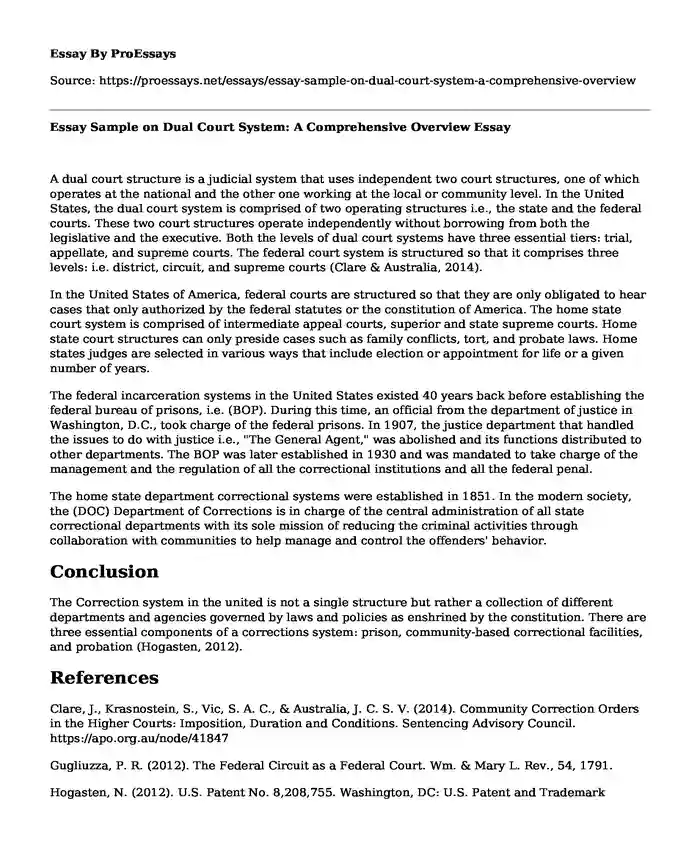A dual court structure is a judicial system that uses independent two court structures, one of which operates at the national and the other one working at the local or community level. In the United States, the dual court system is comprised of two operating structures i.e., the state and the federal courts. These two court structures operate independently without borrowing from both the legislative and the executive. Both the levels of dual court systems have three essential tiers: trial, appellate, and supreme courts. The federal court system is structured so that it comprises three levels: i.e. district, circuit, and supreme courts (Clare & Australia, 2014).
In the United States of America, federal courts are structured so that they are only obligated to hear cases that only authorized by the federal statutes or the constitution of America. The home state court system is comprised of intermediate appeal courts, superior and state supreme courts. Home state court structures can only preside cases such as family conflicts, tort, and probate laws. Home states judges are selected in various ways that include election or appointment for life or a given number of years.
The federal incarceration systems in the United States existed 40 years back before establishing the federal bureau of prisons, i.e. (BOP). During this time, an official from the department of justice in Washington, D.C., took charge of the federal prisons. In 1907, the justice department that handled the issues to do with justice i.e., "The General Agent," was abolished and its functions distributed to other departments. The BOP was later established in 1930 and was mandated to take charge of the management and the regulation of all the correctional institutions and all the federal penal.
The home state department correctional systems were established in 1851. In the modern society, the (DOC) Department of Corrections is in charge of the central administration of all state correctional departments with its sole mission of reducing the criminal activities through collaboration with communities to help manage and control the offenders' behavior.
Conclusion
The Correction system in the united is not a single structure but rather a collection of different departments and agencies governed by laws and policies as enshrined by the constitution. There are three essential components of a corrections system: prison, community-based correctional facilities, and probation (Hogasten, 2012).
References
Clare, J., Krasnostein, S., Vic, S. A. C., & Australia, J. C. S. V. (2014). Community Correction Orders in the Higher Courts: Imposition, Duration and Conditions. Sentencing Advisory Council. https://apo.org.au/node/41847
Gugliuzza, P. R. (2012). The Federal Circuit as a Federal Court. Wm. & Mary L. Rev., 54, 1791.
Hogasten, N. (2012). U.S. Patent No. 8,208,755. Washington, DC: U.S. Patent and Trademark Office.https://patents.google.com/patent/US8208755B1/en
Cite this page
Essay Sample on Dual Court System: A Comprehensive Overview. (2023, Sep 25). Retrieved from https://proessays.net/essays/essay-sample-on-dual-court-system-a-comprehensive-overview
If you are the original author of this essay and no longer wish to have it published on the ProEssays website, please click below to request its removal:
- Paper Example on Richard Kuklinski's Crimes
- Should There Be a Constitutional Amendment Banning the Death Penalty? Paper Example
- The US Constitution V. Texas Constitution Essay Example
- A Conspiracy Theory in Trumps America - Essay Sample
- Essay Sample on Japan History
- Essay on Fairness & Equality: Defining Distributive Justice & Its Impact
- Book Review Example - Pocho







